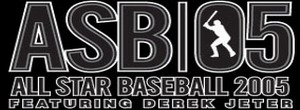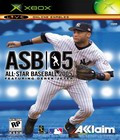Get the ASB 2005 Catcher & Future Throws Trailers off WP (16/17mb)
Future Throws
One of the things that make Major League ballplayers so good defensively is their ability to anticipate. Before a ball is hit they have already determined what they are going to do with it if it comes their way. By anticipating the play beforehand it affords them the ability to react faster by limiting the amount of information they need to process after the ball is hit.
Just like in the Major Leagues, anticipating a play properly can often mean the difference between turning two and cutting a runner down trying to take an extra base. By hitting the button while the ball is on the way to the fielder the fielder will be able to better react creating a much quicker release.
Here’s an example on turning a double-play.
On this hit to shortstop, the user presses the ‘Y’ button to throw to 2nd base BEFORE the ball reaches him.
On this hit to shortstop, the user presses the triangle button to throw to 2nd base BEFORE the ball reaches him.
To complete the DP, the user NOW presses the ‘B button to throw to first before the 2nd baseman even has the ball.
To complete the DP, the user NOW presses the circle button to throw to first before the 2nd baseman even has the ball.
Keep in mind it is often the little fundamentals that mean the difference between winning and losing.
Squeeze Plays
An often-overlooked play in the game of baseball is the squeeze play. The squeeze play is definitely not as glamorous as hitting a 400-foot homerun but it can prove to be just as valuable. Squeeze plays are often put into action when a team is looking to score a go-ahead, a tying, or an insurance run in the late innings. It can prove to be a priceless offensive tool for a weak-hitting club.
In All-Star Baseball when you decide to put a squeeze play into action it is important to remember two important factors, the hitters ability to get the ball down and the pitch count. The likelihood of a squeeze play working dramatically improves based on the bunter’s ability to get the ball down in fair territory and the count in which you decide to put the play into action. The squeeze play should be run in hitter’s counts such as 0-0, 1-0, 1-1, and 2-1 counts.
Cut-Off Man
One part of the game that players spend a lot of time working on in Spring Training is the system of cutoffs. In order for a cutoff to be executed properly a great deal of practice and teamwork is needed. Too many times missed cutoffs have led to extra base hits and unnecessary runs that have given victories to the other team. Many factors go into a successful cutoff such as the speed of the runner, the situation, the outfielders arm, how hard the ball is hit, and how far the outfielder has to move to field the ball.
In All-Star baseball if all of these factors are considered the chances of the cutoff working will increase dramatically. By getting the ball to the cutoff man in a timely fashion it allows the cutoff man to better evaluate the next course of action. For instance, the proper play might not always be to try to prevent the runner from scoring but rather try to prevent another runner from advancing an extra base.
Catching (Pitchouts/Pickoffs/Gundown Runners)
Even though he's often overlooked, there's no one as important on the field as the guy behind the plate. In All-Star Baseball there's a few handy little tricks you can do as your catcher to get baserunners out. And as you know...the less baserunners, the less runs. If a fast baserunner is on 1st or 2nd and you think he might be going on the pitch, you can call for a pitchout. Just throwing the pitch high and outside isn't nearly as effective as calling for a pitchout because your catcher will be off-balance. Hitting the pitchout button gets the catcher up and in a good throwing position before the pitch gets to him, making it much easier to get a throw off quickly. This increases your odds of throwing the runner out significantly.
Another thing the catcher can do to get baserunners out is attempt a pickoff. If the runner has too big of a leadoff and you want to make a quick throw down to the bag, pull and hold in the trigger buttons while the pitch is coming in. This gets the catcher up and in a good throwing position by the time the ball gets there. Then make a snap throw to the base the runner is. Every once in a while, you will catch him sleeping on the basepaths.
More articles about All-Star Baseball 2005





















